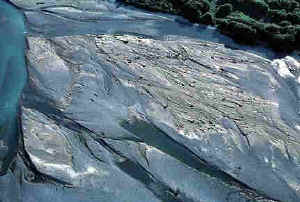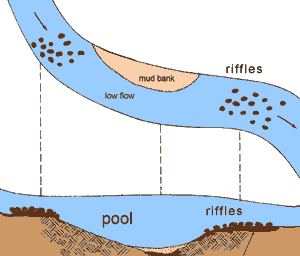|
Surface flows will wiggle and wind through the surface landforms. There
are many flow types depending on the velocity of the river. If the
velocity is high, it tends to cut into bedrock in a "straight"
line. Velocities will be high if there is sufficient relief. When the
velocity is low, the stream will tend to meander if the rock type
and topography permit it.
Water velocity helps to create three basic types of channel patterns,
including braided, meandering, and straight. There are many
patterns that grade into each other. Rivers in a straight pattern do not
stay ruler straight for long! The physical properties of water and the
area the river is eroding tend to have the deepest part of the river
(called the thalweg) alternating from side to side on the
channel. Erosion of the land starts a physical separation of the pieces.
Larger pieces donít move very far and drop out of the system. However,
finer grained sediment settles out in quieter area. So water will be
attacking one side of the river and the other side will be depositing
sediment. Over the years this will create meandering.
In many areas where you find braided channels, surface water is just
"dumped" into a lower topographic area. The sediment load is
large and the river gets confused and breaks up into smaller channels
with a branching, but braided look.
|

Braided streams

|